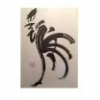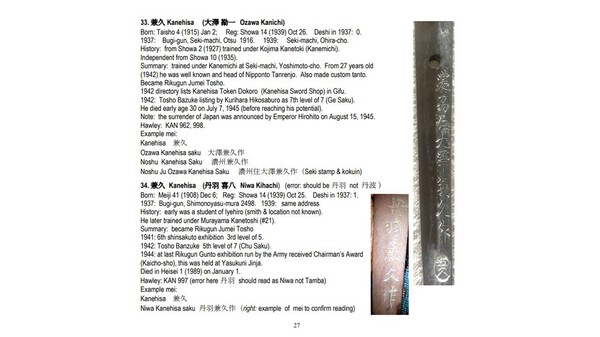-
Posts
832 -
Joined
-
Last visited
-
Days Won
10
Content Type
Profiles
Forums
Events
Store
Downloads
Gallery
Everything posted by mecox
-
Shingunto signed Hizen no Kuni Masatsugu 肥前國正次 with Rikugun Jumei Tosho star stamp plus “ko” and “ho” stamps on nakago mune. Traditionally made water quenched, nagasa 64.2 cm, hamon is suguha based ko-midare with nie deki, boshi is jizo shape with kaen (flames); appears to be muji hada. Blades is dated at June 1943: Koki ni sen roku hiaku san nen roku gatsu kichi jitsu 皇紀二千六百三年六月吉日 “lucky day 6th month 2603 years Japanese Empire” (June 1943). Nakago is ubu with kiri yasurime. Blade in very good condition, in original polish, no bends or rust, but some fine stratches. There is one small fukure blister (1 mm) on edge of hamon. Shingunto koshirae is all original and good condition (one minor dent on saya). Tsuka is all original, ito binding very good, quality same rayskin with large nodules. Brass gunto tsuba with 3 pairs of seppa (no stamped numbers). Locking clip complete and working; brass sarute has sakura pattern. Copper habaki with silver wash. Masatsugu originally from Saga, Hizen, trained in Tokyo at Denshu Jo at Akasaka. He received high ranking at all wartime exhibitions, and returned to Saga around 1942. He was appointed Rikugun Jumei Tosho. Post-war he continued to make swords from 1958 receiving numerous awards. See Article in NMB Downloads for details of Masatsugu and examples. Described in Slough as "medium to high grade gendaito" pages 106-107. Price US$2000 (plus shipping & Ppal).. Blade is in Australia. https://www.militaria.co.za/nmb/files/file/51-taguchi-kiichi-masatsugu-hakuryushi-tadataka/
-
Well this initial challenging post by Piers has caused me substantial loss of sleep, so I had to look further into this tsuba and its design, then could not stop.
-
Bloody hell....well looks like 櫂Kai is the correct term for the tsuba design. And the other term is the origin of the old Japanese song "ro, ro, ro your boat gently down the stream...." . I'm getting ready for that glass!
-
Wow, your concept is very deep, if not oblique..... its morning here, so my view tended not to be enhanced with the benefit of a few reds!
-
Interpreting these tsuba gets a bit philosophical...and you need to ask the maker. But for this one I would go with umbrella (kasa) which is a common design item with rain drops (kasa ni ame); and an oar or paddle (kai). So with an umbrella in a paddled boat, suggests a passenger, so maybe theme is "water taxi" , boatman and passenger in the rain. Re the tsuba, rather small (7.3 cm) suggests small katana (or wakizashi), plus the tsuba looks rather crude and thick, so more like "Tosho" as opposed to "Ko-tosho". The latter are earlier and Muromachi, even Kamakura, and are larger often 8.0-8.5 cm, basic but well made and designs neatly cut, and well forged iron. So themes can be rather open.
-
Piers, maybe Tosho, long sukashi definitely an oar, the other likely an umbrella, but could be old Japanese straw hat. A fisherman? Can you paddle a boat and hold an umbrella?
-
Jarett, Hattori Masahiro here page 30:
-
Kanemune was adopted son of Ichimonji Minamoto Amahide, Seki, see - Member Articles, background and examples.
-
Apologies Ron, should have linked it
-
Ron, yes this is Koketsu Genzaburo Kanetaka (sometimes read as Kanekami) and listed in Sesko swordsmiths. He was born Meiji 32 (1899) and died Showa 38 (1963). He was one of the students of Watanabe Kanenaga school, from Seki, and registered as a Seki swordsmith Showa 15 (1940) July 25. I cant find any examples, but he is in a group photo in Seki around 1952 at opening of Fujiwara Kanefusa forge (see NMB Download article on Kojima family, page 4). He had a student Ogawa Toichi Tofuji (also in Sesko) born Meiji 37 (1904) and registered in Seki Showa 15 (1940) Sept 28. But is an example on NMB February 4, by Frank at Bigsgtg. I missed this one:
-
seems to be around 15% now, as they have cut ties with Paypal and do it themselves. But of course also worst exchange rate, and they hang onto funds for a few days, plus in Aust we get hit with a 10% gst.
-

WW2 Japanese Navy Takayama sword
mecox replied to Swords's topic in General Nihonto Related Discussion
Steve, based on pics 27 Dec kaigunto, nothing appears "wrong" with the tsuka and ito wrapping. Disregard criticism. -
George & others, this is interesting, and may be an unrecorded smith. Based on reading 角屋政光 as Sumiya Masamitsu, I could not find anything in Seki including registration, or in general records. But apparently your sword is Seki stamped in shingunto, with yon-ji mei and sujikai yasurime. The Japan auction site found by Piers https://page.auctions.yahoo.co.jp/jp/auction/l689802003 interestingly has a sword by him, wakizashi 43 cm in bushi mounts with matching yon-ji mei, sujikai filing, Seki shape nakago and also undated. The Torokusho is from Gifu and dated 1992 (Heisei 4) Oct 28. The note says "details are not known". As an exercise I looked at the other reading of family name, Kakuya, which in Sesko came up with: MASAMICHI (政道), Shōwa (昭和, 1926-1989), Gifu – “Masamichi” (政道), real name Kakuya Shōzō (角屋正蔵), born on April 11th 1897 (Meiji 30), he worked as guntō smith. He was registered in Seki on Dec 24, 1941 (Showa 16) and was living at Yoshimoto-cho, Seki-machi. Some tantalizing similarities, but that's all.
-

Contact details for sayagaki translation
mecox replied to Richard Thomas's topic in Translation Assistance
I tried a few, the others beyond me 1. 肥前國藤原忠廣 Higo Kuni Fujiwara Tadahiro 肥前国藤原忠広 (Sesko eSwordsmiths has him on page 1054, using simple "hiro"). He is the 2nd generation Tadahiro. He is in Hawley as TAD37 with the longer "hiro". 4. 近江大掾受領前ノ寛永拾四年頃ノ作也 this looks to say he received the title Omi no Daijo in Kanei ju yon nen (14) which is 1637. Sesko has "he received the honorary title Ōmi no Daijō on the 22nd day of the seventh month Kan´ei 18 (寛永, 1641) 5. 刃長貳尺四寸六分有之 sword length nagasa is 2 saku 4 sun 6 bu which is approx 74.5 cm -

Not Going to Try, but can You?!!!
mecox replied to Bruce Pennington's topic in Translation Assistance
Stainless steel naval sword, Feb 1940 Tenshozan Tanrenjo saku, see Downloads Naval part 2, page 93 -
Eric and others, this looks like Shinoda Hiroshi Ujifusa 篠田 寛 氏房. He was born 20 May, 1912 (Meiji 45) in Seki, and was trained by Kato Jumyo 加藤 寿命, who was from the Watanabe Kanenaga 兼永 school. Ujifusa was producing swords in the early-1930’s and in particular with the increased demands in 1937 after the Japanese invasion of China. At this time there were many requests for shin Nipponto, more than he could supply. Yes the date is Showa 14 (1939) which fits with the Sho/Sakura stamp. But the mei of "Ujifusa" is roughly cut for then, which was more common in late war (1944+). And yes be good to see the koshirae. He is explained in Download file, pages 9 and 49-62:
-
Eric & Others, this is TOKI YUICHI SUKENOBU 土岐 雄一 亮信, younger brother of Toki Kanemasa and a student of Niwa Kanenobu. See Member Articles in Downloads: Seki Toki Swordsmiths - Member Articles - Nihonto Message Board. This is outline of these two swordsmiths.
-
Arielle, here is a summary of Ozawa Kanehisa. He was a very capable swordsmith but died at age 30 almost at the end of the war, so limited examples. He was from Seki in Gifu Prefecture and became a fully trained independent smith at age 20. Your sword looks in good condition. Any more pics?
-
Bruce, in Sesko is : KANETOSHI (兼俊), Shōwa (昭和, 1926-1989), Gifu – “Kanetoshi” (兼俊), “Ikkōsai Kanetoshi” (粋光斎兼俊), real name Kumazawa Shun´ichi (熊沢俊一), born April 20th 1899 (Meiji 32), his gō was Ikkōsai (粋光斎), he worked as guntō smith and was from Seki-machi, Kifune-cho. He registered as a Seki tosho 21 October 1942. The kakihan stamp does have Buddhist association. It is probably a stylised ken straight sword with a "handle", possibly called a sanko-tsuki-ken or sanko-zuka-ken. The ken (or suken) can reflect the incarnation of the deity Fudo Myoo, and the "handle" appears to be a rendai, the lotus petals put beneath an image of the Buddha. This Buddhist symbol is to chase away the devil. But I dont know anything about the smith, how he trained or his relation to Buddhism. He produced quite a few blades, most with Sho/Sakura or Seki stamp, but some with no stamp, and did produce some gendaito. He is also listed in Slough page 70 (which shows he is not Murayama Kanetoshi).
-
Thomas, I will try PM's. No Mino book is not archived on NMB. It is 1993 pre-digital.
-
Thomas, an interesting topic. Although you may have it, attached is some background info. In note Sesko eSwords has a good summary of the Daido smiths pages 63-65. Text here is from 1993 book Mino-To and copies of oshigata, which reflects some variations in reports. The reference and pages of original photos in Fujishiro book are included. There are a few more oshigata in Japanese Sword (cox website) » Oshigata: Mino-to (on.net) Section of Late Koto has 4 and Shinto has 1. I have another 15 or so originals from Japanese books that I will need to copy in 1-2 days. Perhaps I should PM?
-
two different swords
-

"a new stainless steel Japanese sword"
mecox replied to saemonjonosuke's topic in Military Swords of Japan
Johhny & others, yes likely to be Fujiwara Kanenaga. A very skillful and innovative metal worker, maybe ahead of his time. One mei was Nara Taro Fujiwara Kanenaga 奈良 太郎 藤原 兼永. He is summarised here page 71: -

3rd sword tang. It's like a whole bio lol
mecox replied to Bigsgtg's topic in Translation Assistance
Frank, Moriyama san translated your sword: 美濃國関住纐纈源三郎兼上之作 – Mino no kuni Seki ju Koketsu Genzaburo Kanekami made this. 昭和十三年秋 – Showa 13th year (1938), Autumn But it seems his name is also read as Kanetaka, and some of his other names have several readings. There is quite a bit of discussion on this in NMB, so use search for "Kanetaka". In Sesko list: “Kanetaka” (兼上), his real name Kōketsu Genzaburō (纐纈源三郎), born July 8th 1899 (Meiji 32), student of Watanabe Kanenaga (渡辺兼永). He registered as a swordsmith in Seki on 25 July 1940 (Showa 15) and there is called Kokoku Genzaburo Kanekami. 交告 源三郎兼上 In the 1941 sword exhibition 6th Shinsaku Nihontō Denrankai (新作日本刀展覧会, 1941) he was ranked in first level of five level (in the Slough book he is listed as Hanabusa Kanetaka). He worked as a rikugun-jumei-tōshō and in a list of this is called Koketsu Kanetaka. He died December 14th 1963. In the 1942 list of 400 smiths by Hikosaburo Akihide he is ranked as Kibin no Retsu 3rd level of seven an is called Koketsu Kanekami . However, he is recognised as a very good swordsmith. The early date for your sword of 1938 is quite interesting also. -
James, you have picked up a very good sword there Sadashige June 1943 and looks to be in very good fittings. Recognised as a top level swordsmith. Blade looks in fine condition, do NOT get a polish done. By a sword cleaning kit to powder then oil only.






